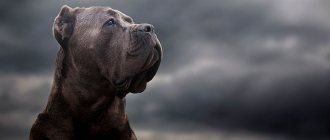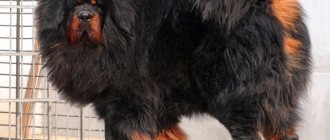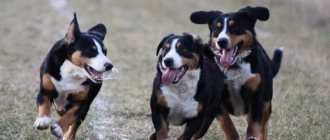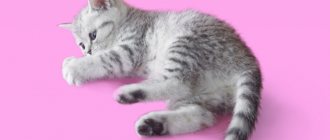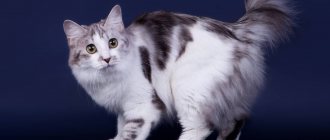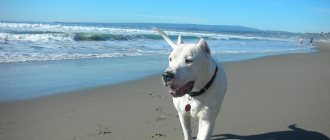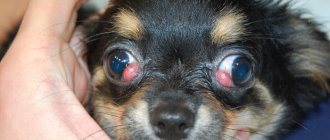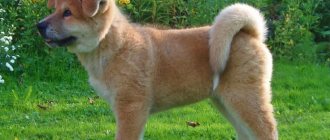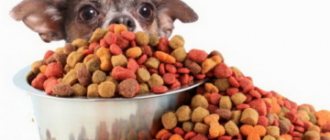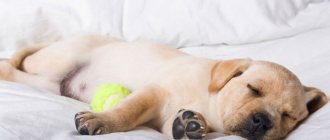Breed standard and description
Height: male 65-75 cm, female 60-68 cm;
Weight: male 60-70 kg, female 50-60 kg.
Color: gray, lead, black, brown and brindle, with small white spots allowed.
Additional characteristics:
- Impressive size, powerful bones and well-developed muscles.
- In appearance he is strong, rough and brutal.
- It has a very massive head, a wide skull and a thick neck.
- The muzzle and head are covered with a pattern formed by characteristic folds.
- With proper development, the dog has high-set, thick and drooping ears, which must be cropped.
History of the Neapolitan Mastiff
The history of the appearance of the breed begins in the southern part of the Apennine Peninsula more than 2 thousand years ago. Its ancestors are considered to be ancient fighting dogs - Molossian Great Danes , which were used to bait wild animals . Molossians were a fashionable pastime for the nobility in Ancient Rome. Commoners kept them as guards for their homes.
The standard for the modern mastiff was developed based on eight representatives of the breed shown in 1946 at an international exhibition. The Italian Mastino Society successfully adopted it in 1949.
Today, this breed is used as a service dog for police, bodyguard and property protector .
The history of the Neapolitan Mastiff breed
The Mastino dog breed has an ancient history of origin. The ancestors of the mastiff, clad in armor, were depicted in paintings in Egypt, Persia, India, and were described in the books of Lucretius. A historical source says that the ancestors of the mastiff guarded herds and caravans . Roman dogs accompanied the legionnaires: the ancient Roman duel was an opportunity to demonstrate the qualities of the dog. Their rivals were a bear, a bull, a jaguar, and a buffalo. Due to their special qualities (fearlessness, intelligence - this was welcomed by the entire ancient world), Alexander the Great fell in love with dogs.
In the middle of the 20th century, the breed was threatened with complete extinction. Professional breeding of individuals in this direction began after the Second World War. In 1947, cynologists, led by Piero Scanziani, selected the best representatives of the breed: 8 individuals were identified. Modern mastiffs originated from them. In 1949, they received a model male and wrote a breed standard based on it.
The breed was professionally bred without checking its physical characteristics. At exhibitions, judges gave preference to individuals in “excessive condition,” which led to a change in the appearance of the mastiff. The breed standard has changed over time; the latest data was adopted in 1999. It is worth noting that among modern representatives of the breed there are record holders: a dog named Hercules was included in the Guinness Book of Records due to its large weight - 128 kg; every day for dinner the dog ate about 1.3 kg of ready-made food, 1 kg of steak.
Character and temperament
Despite its intimidating appearance, it is a balanced and friendly dog with an easy-going character. Throughout his life, he is a big child who requires attention, affection and entertainment. He has good relationships with all family members, but the mastino independently chooses one owner, to whom he remains loyal. If the chosen owner leaves the house even for a short time, the dog becomes sad, and sometimes this even causes him great suffering.
Mastino is good-natured towards visitors to the house, but at the same time he is ready at any moment to rush to the defense of the owner or his property values. Due to his origin, he is completely fearless and very patient with painful sensations.
In comfortable conditions, the dog will behave extremely calmly. She tends to spend her time contemplatively, which is why dog breeders often call Mastino a philosopher. With proper care and respect from her family, she is a sociable, kind, caring dog .
But at the same time, mastiffs are jealous and this feeling is expressed by aggression, and they also have a very good memory. Therefore, families with small children (under 12 years old), as well as those who already have other dogs, should not get a Mastino. Jealousy and enormous size can lead to unpleasant and dangerous situations for both the animal and the owner.
Character and behavior
The gloomy appearance of the dog causes fear and wariness in many people. Don't judge a character by appearance alone: a mastiff is not a ferocious animal. He is sociable, a good guardian, bodyguard, protector, watchman , and shows affection, gentleness, calmness, restraint, and friendliness towards the owner. With proper upbringing, aggression manifests itself when it is absolutely necessary (if an uninvited guest, a stranger, appears in the house, for example). Since an emotional connection is established with the owner, the dog does not tolerate a change of owner well.
To get to know the breed better, study the basic qualities of individuals. Mastiffs are:
- devoted;
- clean;
- balanced;
- solid in character.
Strength and nobility
The grace and strength of the “giants” are fascinating, their character is noble: dogs are never the first to get into a fight. The pet attacks in a situation of increased danger. As a rule, before and during a fight with an opponent, a heavy mastiff does not bark: sometimes a dull growl is heard. Due to the dog's nobility and patience the fight may be postponed for some time , but if the fight takes place, the dog will fight until the enemy completely capitulates or until the owner gives the appropriate command.
Relationships with people
The main difference between the breed is its complete dependence on its owners. When communicating, you will feel reciprocity. The dog is observant: it stays near the owner for a long time, watching what every member of the household is doing. Mastino strives to please his owners in everything. If you want to leave the house to the dog, do not doubt the safety of your property and children. Mastinos will show care, patience, and calmness towards babies. Aggression and bitterness are shown only towards ill-wishers: if family members are in danger, the dog will not hesitate to give its life to protect its owners.
Many owners claim that Mastinos are able to think and communicate with their owners: a person talks about his experiences, and there will be a feeling that the dog listens and understands everything. When communicating with a Mastino, keep your distance, because too close proximity can subsequently provoke jealousy in dogs: they react negatively to their owners’ communication with other animals and strangers.
High intellectual abilities
The ancestors of the mastiff were prone to intelligence, so modern individuals are distinguished by a strong mind and good memory. Mastino should not be beaten, treated with rudeness or harsh gestures, otherwise the dog will become nervous and uncontrollable. If you need to show your pet that he did something wrong, raise your voice and hit him lightly on the back with a rolled-up newspaper. This way the dog will understand that he behaved wrongly and will try to make amends. Many owners note that this behavior of the pet creates the impression that in front of you is not an animal, but a person.
Maintenance and care
The Neapolitan Mastiff is not the easiest dog to care for.
In addition to the fact that this dog requires a large area for movement, it is not very clean . The Mastino salivates profusely and scatters food and water when feeding. The mastiff does this not out of harm, it’s just the structure of his muzzle. Therefore, you need to prepare a place with an easy-to-clean surface, which must be cleaned after each meal.
This breed is problematic to keep in a standard city apartment. She needs space, so a large house is .
When caring for a Mastino, you need to constantly monitor the condition of its coat and skin folds. Nail trimming is also necessary. You should bathe your dog only when necessary or if it is very dirty.
Requirements for maintenance and care
If with the character of the Neapolitan mastiff everything is relatively clear and simple, then the maintenance of such a giant is a process with peculiarities. Yes, the dog is inactive, he would rather lie on a bed than rush around the house, but still in the apartment he turns into an all-dropping lump. It’s also difficult to call a mastiff a clean dog; when he eats or drinks, splashes certainly fly everywhere. But do not think that this is due to the harmfulness and carelessness of a particular individual - the structure of the muzzle still leaves its mark on manners.
Mastino Neapolitans are incredibly slobbery: lying on the couch, walking around the house, playing with you - everything will be covered in drool. Remember the movie “Turner and Hurtch”, yes, there is a different breed, but the mastiff, just like Hutch, will cover everything around with drool, again due to the structure of its muzzle.
IMPORTANT: the breed does not tolerate heat as well as cold, so a shelter in a cool place in the summer and a warm place in the house in the winter are necessary for your big guy.
As we said before, active walking is not required, but don't let your Mastiff become lazy all the time. Go for walks 2 times a day, in the morning you can spend 30 minutes, and in the evening you can walk for an hour. Despite its gigantic size, this is enough for the mastiff from Italy. Rare specimens are ready to play with a ball or train regularly; most often you get an imposing companion for an evening promenade.
Hygiene is simple, but takes time precisely because of the size of the dog:
- Brush the coat 2 times a week with a brush, and during the shedding period, remove dead skin cells and hairs every other day. This way your mastiff will always shine with health and smell less.
- Multiple skin folds will have to be checked every day. Clean your mastiff in the evening from food debris and dirt, this will prevent a number of diseases and minimize the risk of skin irritation.
- You can bathe an adult mastiff 4 times a year using special products.
- The eyes are wiped with tampons with chamomile solution once a day to prevent conjunctivitis from getting a chance.
- Ears are cleaned every 3-4 days.
- Trim the nails once a month, since due to the dog’s sedentary lifestyle, they naturally wear down little.
- Massage with a special brush is required 3-4 times a week so that the folded skin does not suffer from blood stagnation.
- Neapolitans have their teeth brushed once a week.
It is advisable to feed the breed with ready-made food, since the natural type of feeding should be constantly adjusted together with veterinarians.
IMPORTANT: the dog must have constant access to fresh water, since along with constant drooling, fluid loss also occurs.
The owner should also know and remember that improper or insufficient care for a Neapolitan Mastiff dog leads to the development of a number of diseases, such as:
- Skin diseases due to neglect of skin fold care - demodicosis, pyoderma.
- Excessive loads or, conversely, lack of mobility - joint dysplasia, cardiomyopathy.
- Missed disorders of internal organs - hypothyroidism, progressive retinal atrophy
- Difficult childbirth - here, of course, nothing depends on the owner himself, but it is better to be prepared and invite a doctor to the house if during the course of pregnancy the veterinarian suspects possible complications.
In general, it should be noted that, despite its impressive size, the Neapolitan Mastino is a fairly simple dog. Yes, big, and expensive, but cozy and good-natured to the extent of its size, and in the right hands capable of becoming the same faithful and devoted watchdog that once protected the houses of Ancient Rome from prying eyes.
Feeding the dog
Since this is a large dog, it requires complete, high-quality, but at the same time fairly moderate nutrition. However, feeding puppies and adult dogs has significant differences.
In the first year of life, a young animal vitally needs the addition of vitamins (especially group B) and minerals to the food, which strengthen the immune and nervous systems and promote the proper development of joints , which is very important for such large breeds.
For proper development, the puppy must consume a sufficient amount of protein , which is at least half of the total daily diet. Until the age of three months, the puppy requires four meals a day. As it grows, it is reduced to twice a day.
It is recommended to feed adult mastiffs with professional dry food, which maintains the required balance of nutrients to ensure good health and alertness for the dog.
Natural products are also acceptable, but for such large breeds only a veterinarian can choose the right diet. The dog constantly needs a lot of water to drink.
Education and training
Neapolitan Mastiffs are smart and calm dogs, so training is not particularly difficult. These giants quickly and easily remember everything they are taught.
At the same time, in the absence of proper upbringing, you risk soon getting an uncontrollable animal, which is dangerous given its size.
Due to its character, the small mastiff must always be surrounded by people , both indoors and outdoors. This will somewhat reduce the natural suspicion of the Neapolitan.
House guests should also know the rules of behavior with a dog , not to provoke it again and not to cause aggression. It is forbidden to actively gesticulate, force affection or play, and it is forbidden to shout or hit the animal. If the mastino does not feel danger, he simply stops noticing outside visitors.
Care and maintenance
- Up to a year, you need to be very careful about your pet’s nutrition and give vitamins/microelements. Do not overfeed, otherwise joint problems will arise. In addition, many dogs are susceptible to allergies and certain feeding rules must be followed.
- Dogs under 6 months of age should not go down stairs.
- The eyes are prone to inflammation. Take care of your eyes and ears – clean them daily.
- Wipe all folds daily with a damp cloth to avoid the appearance of fungus and skin diseases.
- Mastino is a very difficult breed to raise.
- Dental care. It is enough to examine the teeth and oral cavity of Mastina Neapolitan once a week. As for the care itself, during a thorough examination you should pay attention to: The condition of the gums - if they are red and inflamed, it is recommended to contact a veterinarian who will recommend special medications or remedies;
- Teeth color – ideally, it should remain normal, without plaque (you can clean it yourself) and purulent formations. To maintain teeth in good condition, special bones and toothpastes for dogs can be very useful;
- Dental health – check for loose or broken teeth. Between them there should also be no food residues, the accumulation of which causes the animal to develop an unpleasant odor from the mouth and subsequently rot;
- The presence of tartar - in this case, it is impossible to do without the intervention of a veterinarian and its removal. It should also be noted that an important factor for the health of Mastina Neapolitan - and in particular teeth - is proper balanced nutrition.
Remember that all dog grooming procedures help to establish a relationship with the dog and train him to be disciplined. Regular checking of the Neapolitan Mastine puppy will develop into a kind of obligatory and pleasant communication procedure. If you notice any changes in behavior or find any unexplained sores or redness, contact your veterinarian.
Health and life expectancy
The Neapolitan Mastiff has good health and most diseases occur due to improper care. Any disease manifests itself in decreased activity and a general lethargic state. In this case, you need to urgently consult a veterinarian, since the disease often becomes chronic and torments the animal throughout its life.
First of all, the puppy needs to have his first vaccinations, if they were not done in the kennel.
Specific diseases of this breed include:
- Various forms of allergies, skin diseases;
- Excess weight acquired due to improper feeding;
- When about to lie down, the mastiff falls heavily and his elbow joints hit the surface of the floor covering. Over time, the animal develops bursitis , as a result of which the joints begin to accumulate fluid, and large blisters are observed on the elbows. Therefore, if you decide to have a Mastino, you should take care of soft flooring .
- Puppies often gain body weight very quickly, while the development of joints, ligaments and muscles is delayed. In this case, the animal suffers from muscle and joint pain, and this can also lead to the development of hip dysplasia.
With proper maintenance and care, Neapolitans can live up to 11 years .
History of the origin of the breed
This giant dog has roots going back centuries. The ancestors of this breed are considered to be ancient fighting dogs belonging to the Molossians, which presumably descended from ancient Egyptian and Assyrian dogs. The first mentions of mastiffs are found in documents dating back to the time of the Roman Empire. Then these majestic and formidable dogs were used in battles. They were dressed in metal armor and released onto the battlefield. They often took part in spectacular events in the arenas of Ancient Rome.
In addition to participating in battles , these dogs were also kept by ordinary residents: butchers, farmers, peasants. Due to their enormous size, mastiffs were often used as draft force - they were harnessed to special carts, and in this way they transported cargo. Currently, mastiffs are mainly used as a guard dog.
After the collapse of the Roman Empire, the popularity of this breed declined sharply. Mainly mastiffs became common in Naples. Therefore, the modern name of this breed sounds like the Neapolitan Mastiff.
Centuries of crossing Neapolitan mastiffs with Iberian mastiffs similar to this breed, as well as spontaneous crossing with dogs of other breeds, gradually led to the degeneration of the breed. Only in the mid-twentieth century, thanks to the efforts of Pietro Scanziani, the breed was restored. It was his dog that in 1949 became the model for describing the breed standard. This standard, with some additions, is still used today. The last amendments to it were made in 1999.
How much does it cost and where can I buy it?
The Neapolitan Mastiff is a serious dog. Therefore, in order to avoid all sorts of risks, you should purchase it only from a specialized nursery. In order not to end up with an uncontrollable predator, a pedigree for this breed is required .
While in the nursery, you can independently test the puppies for psychological stability . You need to carefully observe their reaction to sudden sounds and movements, as well as to strangers. A healthy puppy will be curious at first, but after looking around and making sure that nothing threatens him, like any child, he will begin to play with you. If he attacks or, on the contrary, runs away and hides, then you should not risk buying such a dog.
A healthy young mastiff is characterized by:
- Excellent appetite;
- High activity;
- Have a restful sleep;
- He must be moderately well-fed, have clean skin, fur, eyes and ears.
If any indicator has significant deviations from the norm, it is better to refuse the purchase. It is also necessary to find out what vaccinations were given to him, and it is best to leave the selected animal in the nursery until the end of quarantine. It is advisable to meet the parents of your future security guard.
In addition to the above, purchasing a puppy from a reliable nursery will ensure that you have a full set of necessary documents, including a puppy card and a veterinary passport. You will be able to contact the nursery specialists for advice in the future with all the problems and questions that arise.
Puppy price: 40,000 - 100,000 rubles .
Pet care rules
Pay attention to the coat: caring for it involves regular brushing and combing. Keep in mind that an Italian Dogo sheds for 10-14 days - during this time, brush your dog daily. Bathing is carried out every season or before exhibitions. Frequent water treatments are not recommended due to the dog having delicate skin that is not protected by the undercoat. Excessive bathing causes itching, irritation, and dandruff.
With proper care and maintenance, the Italian Great Dane produces virtually no unpleasant odor, but the breed belongs to the “slobbery” category, so it is important to regularly wipe its face. If this is not done, bacteria will actively multiply on a wet chin. In addition, excessive salivation causes damage to furniture and clothing.
Carefully examine the eyes and ears of your Great Dane: clean them once every 2-4 days. If the claws do not wear out naturally, then shorten them with a device like a guillotine nail cutter for large individuals. Have your teeth examined for plaque and have them cleaned at a veterinary clinic. Keep in mind that when feeding your pet with ready-made food, the risk of plaque formation is minimal.
After walks, there may be blood-sucking insects on your pets, so carefully inspect your dog’s skin. To protect the animal, regularly use special drops and sprays (they are applied to the withers). Remember that bites of blood-sucking insects (mosquitoes, ticks) can lead to various diseases of the heart and lungs, from which the dog often dies.
- Pancakes without eggs
- Roast chicken - step-by-step recipes for cooking in a saucepan, slow cooker or oven
- 4 innovations for Russian motorists from July 1
Breed photo
A selection of photos of Neapolitan mastiffs.
